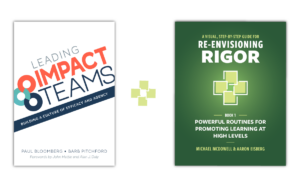Rigor is often misunderstood. Too frequently, it is equated with more work, harder assignments, or increased academic pressure. But true rigor is not about piling on tasks—it’s about deepening understanding, fostering cognitive complexity, and supporting students in transferring their knowledge to new and authentic contexts.
 This past month I had the honor of co-presenting with author, Dr. Michael McDowell, where we integrated our two passions 1) my passion for developing assessment-capable learners and 2) his passion and the topic of his new book with Aaron Eisberg, A Visual, Step-By-Step Guide for Re-Envisioning Rigor: Powerful Routines for Promoting Learning at High Levels. I learned a lot while building our PL session together. It pushed me to think differently about the goal of developing assessment capability by reframing it as a “rigorous endeavor”.
This past month I had the honor of co-presenting with author, Dr. Michael McDowell, where we integrated our two passions 1) my passion for developing assessment-capable learners and 2) his passion and the topic of his new book with Aaron Eisberg, A Visual, Step-By-Step Guide for Re-Envisioning Rigor: Powerful Routines for Promoting Learning at High Levels. I learned a lot while building our PL session together. It pushed me to think differently about the goal of developing assessment capability by reframing it as a “rigorous endeavor”.
John Hattie’s Surface-Deep-Transfer model offers a powerful framework for conceptualizing rigor. It challenges us to consider rigor as a progression of learning, rather than a fixed level of difficulty. When rigor is embedded into instructional design with intention, it cultivates assessment-capable learners—students who can reflect on their own learning, set meaningful goals, and take ownership of their educational journey. This, in turn, strengthens learner agency, ensuring that students are not just passive recipients of knowledge but active participants in constructing meaning.
Rigor Through the Lens of Hattie’s Surface-Deep-Transfer Model
Hattie’s research on learning progression distinguishes three phases:
- Surface Learning: The foundational stage where students are introduced to concepts, vocabulary, and basic skills. At this level, rigor means ensuring that students make initial connections and develop accuracy in their understanding.
- Deep Learning: The stage where students apply reasoning, make connections, and engage in analysis. Rigor here means moving beyond memorization to seeing relationships and using evidence to support thinking.
- Transfer Learning: The ultimate goal, is where students use their knowledge in new, real-world contexts. Rigor at this level is about adaptability—students demonstrating their ability to think critically and apply skills independently.
Rigor and Assessment Capability
Rigor is not just about making learning more difficult—it’s about making learning more intentional, connected, and transferable. True rigor supports students in developing a deeper understanding of content while also equipping them with the skills and strategies necessary to navigate their own learning process. This is where assessment capability becomes critical.
An assessment-capable learner is a student who can:
→ Understand where they are in their learning (recognizing strengths and gaps),
→ Identify where they need to go (setting clear, meaningful goals), and
→ Determine how to get there (using strategies, resources, and feedback to progress).
These capabilities align directly with Hattie’s Surface-Deep-Transfer model, ensuring that rigor is not just about acquiring knowledge but about building self-directed learners who can think critically, reflect on progress, and apply learning in new ways.
Here’s how assessment capability develops across the progression of rigor:
- Surface Level: Building Awareness Through Self-Assessment and Goal Setting
At the surface level, students are in the early stages of learning a concept or skill. This is when they begin to self-assess and set goals based on clear success criteria. The focus here is on recognizing what they already know, identifying gaps, and developing accuracy in foundational knowledge.
Example: A 2nd-grade student learning about story structure uses a visual checklist to track whether their story has a beginning, middle, and end. By comparing their work to a model, they can recognize missing elements and set a goal to improve their story’s clarity.
- Deep Level: Strengthening Understanding Through Peer and Self-Reflection
As students move beyond the surface, they begin to connect ideas, analyze relationships, and refine their thinking. At this stage, they engage in peer and self-reflection, using feedback loops to improve their work and adjust strategies. The focus shifts from “Did I get it right?” to “How can I improve my understanding?”
Example: A middle school student working on argumentative writing engages in peer feedback using a structured rubric. After reading a classmate’s feedback, they revise their essay, strengthening their reasoning and evidence. This reflective process helps them recognize writing as an iterative skill that grows through revision.
- Transfer Level: Demonstrating Agency Through Self-Regulation and Application
At the highest level of rigor, students use self-regulation strategies, apply their learning across different subjects and real-world situations, and advocate for their own learning needs. Here, they are not just consumers of knowledge—they become creators and problem-solvers who apply their skills in meaningful ways.
Example: A high school science student researching climate change applies their knowledge of data analysis to create an infographic presenting local environmental trends. They then use their findings to advocate for sustainable practices at a community meeting, demonstrating their ability to transfer learning into action.
By embedding assessment capability into rigorous learning experiences, we empower students to take ownership of their growth, fostering learner agency that extends beyond the classroom. Instead of passively completing assignments, they become active participants in their own learning journey—driving their progress, adjusting their strategies, and applying their skills in ways that matter.
Learner Agency as the Outcome of Rigor
Rigor is not just about what students know—it’s about what they can do with that knowledge. When learning is intentionally rigorous, it equips students with the tools to take charge of their learning, navigate challenges, and make informed decisions. This is learner agency in action—the ability of students to take ownership of their learning process, rather than relying solely on teachers to direct their path.
Why does this matter? Because agency is the foundation of lifelong learning. A student with agency doesn’t just complete assignments; they actively engage in inquiry, make connections, and apply knowledge in meaningful ways. This shifts the focus from compliance to empowerment, ensuring that learning is not something that happens to students but something they drive.
What Does Learner Agency Look Like in Practice?
- They ask metacognitive questions to deepen understanding.
- In a middle school science class, students learning about ecosystems don’t just memorize food chains. Instead, they ask:
- How does energy transfer in an ecosystem?
- How do human actions affect these relationships?
- How does energy transfer in an ecosystem?
- Rather than simply recalling facts, they engage in self-questioning, which allows them to push beyond surface learning and critically examine real-world ecological issues.
- In a middle school science class, students learning about ecosystems don’t just memorize food chains. Instead, they ask:
- They track their progress and make adjustments as needed.
- A 5th-grade student working on a narrative writing piece uses a checklist and rubric to self-assess their draft. They recognize that their descriptive language is weak compared to the criteria for strong writing. Instead of waiting for teacher feedback, they revise their work, using mentor texts and peer feedback to strengthen their descriptions.
- By self-monitoring, students develop resilience and independence, learning that growth comes from adjusting and refining their thinking—not just from receiving grades.
- They transfer learning into meaningful actions, applying their knowledge to solve real-world problems.
- In a high school civics class, students studying the Bill of Rights don’t just memorize amendments. Instead, they analyze current events and create a podcast discussing how free speech laws apply in digital spaces.
- By connecting classroom learning to real-world issues, they move from deep learning to transfer, demonstrating ownership over their learning and using knowledge as a tool for advocacy and change.
Why This Matters: The Power of Rigor in Cultivating Agency
When rigor is framed as a pathway to student self-empowerment, rather than just increased difficulty, we cultivate learners who are:
→ More engaged – They take an active role in their education.
→ More self-directed – They develop the skills to regulate their learning, rather than waiting for instructions.
→ More prepared for the real world – They can apply their learning in new and meaningful ways.
This is why rigor matters. Not to make school harder, but to make learning more purposeful. When we design learning experiences that follow Hattie’s Surface-Deep-Transfer model, we are not just teaching content—we are shaping students who will own their learning journey for life.
Instead of seeing rigor as an external pressure imposed on students, we should reimagine it as an internal capacity that we build within them—a capacity that allows them to navigate challenges, think critically, and become agents of their own learning.
Join our Impact Teams community to revolutionize your PLCs!
References:
- Bloomberg, P. J., & Pitchford, B. (2023). Leading Impact Teams: Building a Culture of Efficacy and Agency. Mimi & Todd Press.
- Hattie, J. (2012). Visible Learning for Teachers: Maximizing Impact on Learning. Routledge.
- McDowell, M., & Eisberg, A. (2024). A visual, step-by-step guide for re-envisioning rigor: Powerful routines for promoting learning at high levels. Mimi & Todd Press.



